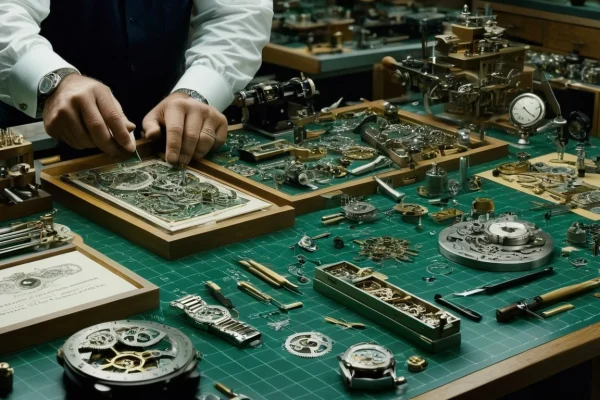Who Inspired the Creation of Rolex?

- Who Inspired the Creation of Rolex?
- The Visionary Behind Rolex
- The Role of Innovation in Watchmaking
- The Oyster Case Revolution
- Impact on Diving Watches
- Influence on Luxury Market
- Automatic Movements and Precision
- The Cultural Impact of Rolex
- Rolex in Popular Culture
- Endorsements and Partnerships
- Frequently Asked Questions
The story behind the iconic Rolex brand is as fascinating as the timepieces it creates. Founded in 1905, Rolex was inspired by a vision of precision and luxury that transcended the ordinary. At the heart of this vision was Hans Wilsdorf, a man whose relentless pursuit of excellence revolutionized the watchmaking industry. His innovative spirit and dedication to quality laid the foundation for what would become one of the most recognizable luxury brands in the world.
Wilsdorf’s journey began in London, where he recognized a gap in the market for high-quality wristwatches. At a time when pocket watches dominated, he envisioned a timepiece that combined elegance with functionality. He believed that a watch should not only be a tool for telling time but also a statement of style and sophistication. This vision drove him to create Rolex, a name that would soon become synonymous with luxury and innovation.
Rolex’s foundation was built on several key principles that continue to guide the brand today:
- Quality Craftsmanship: Each Rolex watch is meticulously crafted, ensuring the highest standards of precision and durability.
- Innovative Technology: From the introduction of the Oyster case to advancements in automatic movements, Rolex has consistently pushed the boundaries of watchmaking.
- Timeless Design: Rolex watches are not just functional; they are works of art that embody elegance and style.
As we delve deeper into the history of Rolex, we can see how Wilsdorf’s vision came to life through groundbreaking innovations. The introduction of the Oyster case in 1926 was a game-changer, providing water resistance and setting new standards for durability. This innovation not only enhanced the functionality of watches but also solidified Rolex’s reputation as a leader in the industry.
In summary, the creation of Rolex was inspired by a visionary who dared to dream big. Hans Wilsdorf’s legacy lives on in every watch that bears the Rolex name, reminding us that true luxury is not just about aesthetics but also about the story behind it. As we explore the impact of Rolex on the watch industry and popular culture, we uncover a rich tapestry of innovation and prestige that continues to captivate enthusiasts and collectors alike.
The Visionary Behind Rolex
At the heart of Rolex’s illustrious legacy is Hans Wilsdorf, a visionary whose relentless pursuit of precision and luxury redefined the watchmaking industry. Born in 1881 in Germany, Wilsdorf moved to Switzerland, where he recognized the potential of wristwatches at a time when pocket watches dominated the market. His innovative spirit led him to establish Wilsdorf & Davis in 1905, which would later evolve into the iconic Rolex brand. Wilsdorf’s foresight in marketing and quality assurance set the foundation for what Rolex would become.
Wilsdorf was not just a businessman; he was a pioneer who believed that a watch should be both functional and stylish. He famously said, “A watch is only as good as its movement.” This philosophy drove him to create timepieces that were not only aesthetically pleasing but also reliable and accurate. His dedication to quality led to the introduction of the first waterproof watch, the Oyster, in 1926, which showcased his commitment to innovation.
To further enhance the brand’s reputation, Wilsdorf employed strategic marketing techniques that included celebrity endorsements and partnerships with prestigious events. This approach effectively positioned Rolex as a symbol of success and sophistication. Today, the brand is synonymous with luxury, and its timepieces are worn by influential figures across various fields.
| Key Contributions of Hans Wilsdorf | Description |
|---|---|
| Waterproof Oyster Case | Introduced in 1926, revolutionized watch durability. |
| Automatic Movements | Enhanced accuracy and convenience in timekeeping. |
| Marketing Innovations | Established Rolex as a luxury brand through strategic partnerships. |
In summary, Hans Wilsdorf’s visionary leadership and groundbreaking innovations laid the groundwork for Rolex’s enduring legacy. His ability to blend functionality with elegance has made Rolex not just a watch brand, but a cultural icon that continues to inspire admiration and aspiration around the globe.
The Role of Innovation in Watchmaking
Rolex has always been at the forefront of innovation in the watchmaking industry. This commitment to innovation is not just about creating new products; it’s about redefining what a watch can be. When you think of luxury watches, you might picture something exquisite and delicate. However, Rolex has taken a different route by combining luxury with functionality. This is evident in their groundbreaking technologies that have set them apart from the competition.
One of the most significant innovations by Rolex is the introduction of the Oyster case. This innovation was revolutionary because it provided water resistance and durability, which were virtually unheard of in luxury watches at the time. Imagine diving deep into the ocean, knowing your watch can withstand the pressure and the water. That’s the kind of confidence Rolex instills in its users. The Oyster case not only enhanced the functionality of watches but also established a new benchmark for quality.
| Innovation | Description | Impact |
|---|---|---|
| Oyster Case | Water-resistant and durable design | Set a standard for reliable luxury watches |
| Automatic Movements | Self-winding mechanism for greater accuracy | Revolutionized timekeeping, enhancing convenience |
Moreover, Rolex’s advancements in automatic movements have transformed the way we think about timekeeping. Before Rolex, many watches required manual winding, which could be a hassle. With automatic movements, the watch winds itself as you wear it, providing unmatched convenience. This innovation has not only made Rolex a benchmark for precision but has also allowed them to cater to a wider audience who values both style and practicality.
In a world where time is of the essence, Rolex’s innovations have made it a household name. Their commitment to excellence and forward-thinking designs has not only shaped their brand but has also influenced the entire watchmaking industry. So, the next time you glance at your Rolex, remember that you’re not just looking at a watch; you’re witnessing a piece of history that continues to evolve.
“Innovation distinguishes between a leader and a follower.” – Steve Jobs
The Oyster Case Revolution
The introduction of the Oyster case by Rolex in 1926 was nothing short of revolutionary. This innovation not only changed the way watches were designed, but it also set a new standard for durability and water resistance in the watchmaking industry. Imagine a timepiece that could withstand the rigors of daily life, whether you were diving into the ocean or simply caught in a rain shower. The Oyster case made that dream a reality.
Before the Oyster case, many watches were susceptible to dust and moisture, often leading to inaccuracies and damage. However, Rolex’s ingenious design created a hermetically sealed case that protected the delicate mechanisms inside. This was a game-changer, particularly for adventurers and professionals who relied on their watches in extreme conditions. The Oyster case’s unique features included:
- Water Resistance: The case could endure depths of up to 100 meters, making it ideal for divers.
- Durability: Crafted from high-quality materials, it was resistant to shocks and scratches.
- Timeless Design: Its elegant look appealed to both functionality and style.
With the Oyster case, Rolex not only catered to watch enthusiasts but also captured the attention of the luxury market. The brand’s commitment to excellence led to the creation of iconic models like the Submariner and the Datejust, which further solidified Rolex’s reputation as a leader in reliable timepieces.
As a testament to its impact, the Oyster case has been featured in various milestones of exploration and adventure. For instance, in 1927, Mercedes Gleitze swam across the English Channel wearing a Rolex Oyster, proving its waterproof capabilities. This event not only showcased the watch’s durability but also cemented its place in history as a symbol of resilience and innovation.
| Feature | Description |
|---|---|
| Water Resistance | Up to 100 meters |
| Material | Stainless steel, gold, and platinum |
| Design | Classic and elegant |
In summary, the Oyster case revolutionized the watchmaking industry by combining innovation with luxury. It not only enhanced the functionality of watches but also paved the way for future advancements in the field. Today, the Oyster case remains a hallmark of Rolex’s commitment to quality, inspiring countless brands to follow in its footsteps.
Impact on Diving Watches
When it comes to diving watches, Rolex is a name that immediately springs to mind. The brand’s commitment to creating robust timepieces has not only set the bar for quality but has also transformed the entire diving watch market. The introduction of the Submariner in 1953 marked a pivotal moment in watchmaking history, as it combined functionality with elegance, appealing to both professional divers and luxury watch enthusiasts alike.
Rolex understood that divers needed a watch that could withstand the harshest underwater conditions while maintaining accuracy. This led to the development of features that became standard in diving watches, including:
- Water Resistance: The Submariner was designed to be water-resistant up to 300 meters, making it a reliable companion for deep-sea exploration.
- Rotatable Bezel: This feature allows divers to track their dive time accurately, ensuring safety during underwater excursions.
- Luminous Markers: The use of luminescent materials ensures that the watch is readable in low-light conditions, a crucial requirement for divers.
In fact, the influence of the Submariner has been so profound that it has become a benchmark for other luxury diving watches. The table below illustrates how the Submariner compares with other popular diving watches in terms of features and specifications:
| Watch Model | Water Resistance | Rotatable Bezel | Luminous Markers |
|---|---|---|---|
| Rolex Submariner | 300 meters | Yes | Yes |
| Omega Seamaster | 300 meters | Yes | Yes |
| TAG Heuer Aquaracer | 300 meters | Yes | Yes |
With these innovations, Rolex not only solidified its status as a leader in the diving watch segment but also inspired countless other brands to prioritize durability and functionality in their designs. As a result, the legacy of Rolex in the diving watch arena is not just about the watches themselves, but about the standards that they set for the entire industry.
In conclusion, the impact of Rolex on diving watches is undeniable. The brand’s dedication to quality and innovation has paved the way for future advancements, ensuring that divers and adventurers alike can rely on their timepieces, no matter how deep they go.
Influence on Luxury Market
The impact of Rolex on the luxury watch market is nothing short of monumental. When you think of luxury watches, the name Rolex likely springs to mind almost instantly. This isn’t just by chance; the brand has meticulously crafted its image over the decades, setting a benchmark that many aspire to reach. The success of the Oyster case, in particular, has paved the way for a new era of luxury watches where durability meets style.
Rolex’s influence extends beyond just their products; it has reshaped the entire landscape of luxury watchmaking. Other brands have taken note, realizing that consumers are not only looking for aesthetic appeal but also for functionality and reliability. This shift can be seen in the way many luxury brands have begun to prioritize robust designs and advanced technologies in their offerings.
To illustrate this influence, consider the following table that showcases how Rolex has inspired other luxury brands:
| Brand | Inspired Feature | Rolex Model |
|---|---|---|
| Omega | Water Resistance | Seamaster |
| Tag Heuer | Precision Timing | Monaco |
| Breitling | Aviation Functionality | Navitimer |
Moreover, Rolex’s strategic marketing has played a crucial role in its luxury status. The brand has expertly aligned itself with high-profile events, such as:
- Wimbledon
- The Oscars
- Formula 1 Racing
These partnerships not only showcase Rolex watches in glamorous settings but also reinforce the brand’s association with excellence and prestige. Through these endorsements, Rolex has solidified its position as a premier luxury brand, transcending the realm of mere timekeeping to become a coveted status symbol.
In conclusion, the influence of Rolex on the luxury market is profound and enduring. It has not only revolutionized watchmaking but also set a standard that continues to inspire countless brands. As you look at your wrist, remember that wearing a Rolex is not just about telling time; it’s about embracing a legacy of excellence.
Automatic Movements and Precision
The evolution of automatic movements has been nothing short of revolutionary in the world of horology. Rolex, renowned for its commitment to precision, has consistently pushed the boundaries of what is possible in watchmaking. Automatic movements allow watches to wind themselves through the natural motion of the wearer’s wrist, eliminating the need for manual winding. This innovation not only enhances convenience but also ensures that the timepiece remains accurate and reliable. Imagine never having to worry about winding your watch again—it’s a game-changer!
Rolex’s dedication to precision is evident in its meticulous craftsmanship and engineering. Each automatic movement is designed with intricate components that work harmoniously to provide exceptional timekeeping. The brand’s signature Caliber 3130, for example, is a testament to Rolex’s relentless pursuit of excellence. This movement features:
- Self-winding mechanism: Harnessing the power of kinetic energy.
- Chronometer certification: Ensuring unrivaled accuracy.
- Durability: Built to withstand the rigors of everyday life.
Rolex’s automatic movements have set a benchmark in the watch industry, influencing other manufacturers to adopt similar technologies. This shift has not only improved the overall quality of luxury watches but has also elevated consumer expectations regarding precision and reliability. The brand’s innovations have become synonymous with luxury, making Rolex a household name among watch enthusiasts and collectors alike.
| Feature | Description |
|---|---|
| Self-Winding | Automatically winds the watch using the wearer’s wrist movement. |
| Chronometer Certified | Indicates that the watch has passed rigorous accuracy tests. |
| Durability | Designed to withstand shocks, water, and other elements. |
In conclusion, the automatic movements developed by Rolex have not only revolutionized timekeeping but have also solidified the brand’s reputation as a leader in precision and luxury. With each tick of a Rolex watch, you can feel the legacy of innovation and craftsmanship that continues to inspire both watchmakers and enthusiasts around the globe.
The Cultural Impact of Rolex
Rolex isn’t just a watch; it’s a cultural phenomenon that has transcended the realm of horology. The brand has become synonymous with success and prestige, making it a coveted accessory among celebrities, athletes, and influential figures around the globe. This transformation into a cultural icon didn’t happen overnight; it was a carefully crafted journey that intertwined innovation with strategic marketing.
One of the most fascinating aspects of Rolex’s cultural impact is its presence in popular culture. From the silver screen to the sports arena, Rolex watches have been spotted on the wrists of some of the most famous personalities in the world. For instance, the likes of James Bond and Roger Federer have donned these timepieces, further enhancing their allure. The association with such high-profile figures has solidified Rolex’s status as a luxury symbol.
Moreover, Rolex has established strategic partnerships with prestigious events and organizations, which has played a significant role in reinforcing its image. Events like Wimbledon, the Oscars, and the Formula 1 races are just a few examples where Rolex has made its mark. These partnerships not only elevate the brand’s status but also bridge the gap between elite culture and watchmaking. Here’s a table showcasing some of these key partnerships:
| Event/Organization | Year Established | Role of Rolex |
|---|---|---|
| Wimbledon | 1978 | Official Timekeeper |
| The Oscars | 2016 | Exclusive Timepiece Partner |
| Formula 1 | 2013 | Official Timekeeper |
In addition to its partnerships, the brand’s marketing strategies have played a crucial role in shaping its cultural narrative. Rolex’s commitment to excellence and precision has made it a benchmark for other luxury watchmakers, setting a standard that others aspire to reach. This is why when you see a Rolex, you don’t just see a watch; you see a legacy of innovation and prestige.
Ultimately, Rolex has managed to weave itself into the fabric of modern culture, making it not just a timepiece but a statement of one’s achievements and aspirations. So, the next time you spot a Rolex, remember, it’s more than just a watch—it’s a symbol of success and luxury.
Rolex in Popular Culture
When you think of luxury watches, Rolex undoubtedly springs to mind. But it’s not just about the timepieces; it’s about the cultural phenomenon that Rolex has become. From the glitz of Hollywood to the thrill of sports arenas, Rolex has woven itself into the fabric of our lives, symbolizing success and prestige. Have you ever noticed how a simple watch can elevate an outfit, or even a person’s status? That’s the magic of Rolex!
One of the key elements that contribute to Rolex’s iconic status is its presence in popular culture. Celebrities, athletes, and influential figures have been spotted flaunting these luxurious timepieces, making them a must-have accessory. For instance, the likes of Roger Federer and James Bond have famously showcased their Rolex watches, linking the brand with excellence and sophistication.
| Celebrity | Rolex Model | Context |
|---|---|---|
| Roger Federer | Rolex Datejust | Worn during tennis matches |
| Paul Newman | Rolex Daytona | Iconic in racing circles |
| James Bond | Rolex Submariner | Featured in multiple films |
Moreover, Rolex’s strategic endorsements and partnerships have further solidified its position in the luxury market. The brand is often associated with prestigious events such as Wimbledon and the Oscars, creating an aura of exclusivity. These collaborations not only enhance the brand’s image but also connect it with the elite culture that surrounds these events.
In conclusion, the allure of Rolex in popular culture is undeniable. It represents more than just a timepiece; it’s a statement of success and achievement. Whether you’re a sports fan, a movie buff, or someone who appreciates fine craftsmanship, a Rolex watch is a symbol that resonates deeply across various facets of life.
Endorsements and Partnerships
Rolex’s success is not solely attributed to its innovative timepieces; the brand has masterfully crafted a narrative through strategic endorsements and partnerships. By aligning itself with prestigious events and influential personalities, Rolex has cemented its status as a symbol of luxury and excellence. Think about it—when you spot a Rolex on the wrist of a world-class athlete or a Hollywood star, it’s not just a watch; it’s a statement. This synergy between the brand and its ambassadors creates an aura of desirability that is hard to resist.
One of the most notable partnerships is with the Wimbledon Championships, where Rolex has been the official timekeeper since 1978. This relationship not only highlights the brand’s commitment to precision but also places it in the heart of one of the most prestigious tennis tournaments in the world. Similarly, Rolex’s association with the Oscars enhances its visibility in the film industry, showcasing the brand as a staple of elegance on the red carpet.
Here’s a brief overview of some key endorsements and partnerships that have shaped Rolex’s cultural impact:
| Event/Partnership | Year Established | Significance |
|---|---|---|
| Wimbledon | 1978 | Official timekeeper, enhancing brand prestige in sports. |
| Oscars | 2016 | Presence in the film industry, showcasing luxury and elegance. |
| Formula 1 | 2013 | Association with speed and precision, aligning with high-performance. |
Moreover, Rolex’s collaborations with renowned athletes, such as tennis legends Roger Federer and golf icons like Tiger Woods, further amplify its appeal. These athletes embody the spirit of excellence that Rolex represents, making their association with the brand a natural fit. In a world where every detail matters, Rolex’s strategic partnerships and endorsements not only enhance its visibility but also reinforce its identity as a leader in the luxury watch market.
In conclusion, Rolex’s endorsements and partnerships are more than just marketing tactics; they are integral to the brand’s narrative, intertwining luxury with cultural significance. By bridging the gap between watchmaking and elite culture, Rolex continues to inspire admiration and aspiration across the globe.
Frequently Asked Questions
- Who founded Rolex?
Rolex was founded by Hans Wilsdorf in 1905. His vision and innovative spirit were crucial in establishing Rolex as a leader in the luxury watch market.
- What is the significance of the Oyster case?
The Oyster case was a groundbreaking innovation introduced by Rolex, providing water resistance and durability. This design not only enhanced the functionality of watches but also set a new standard for luxury timepieces.
- How did Rolex influence diving watches?
Rolex’s commitment to creating robust diving watches led to the development of the Submariner, which became essential for professional divers. This model showcased Rolex’s dedication to performance and reliability in extreme conditions.
- What advancements did Rolex make in automatic movements?
Rolex revolutionized timekeeping with its advancements in automatic movements, allowing for enhanced accuracy and convenience. This positioned Rolex as a benchmark for precision in the watch industry.
- Why is Rolex considered a status symbol?
Beyond its technical achievements, Rolex has become a symbol of success and status. Its presence in popular culture, from celebrities to sports icons, has further elevated its allure among consumers.
- What are some notable partnerships of Rolex?
Rolex has formed strategic partnerships with prestigious events like Wimbledon and the Oscars, reinforcing its reputation as a premier luxury brand and linking watchmaking with elite culture.





